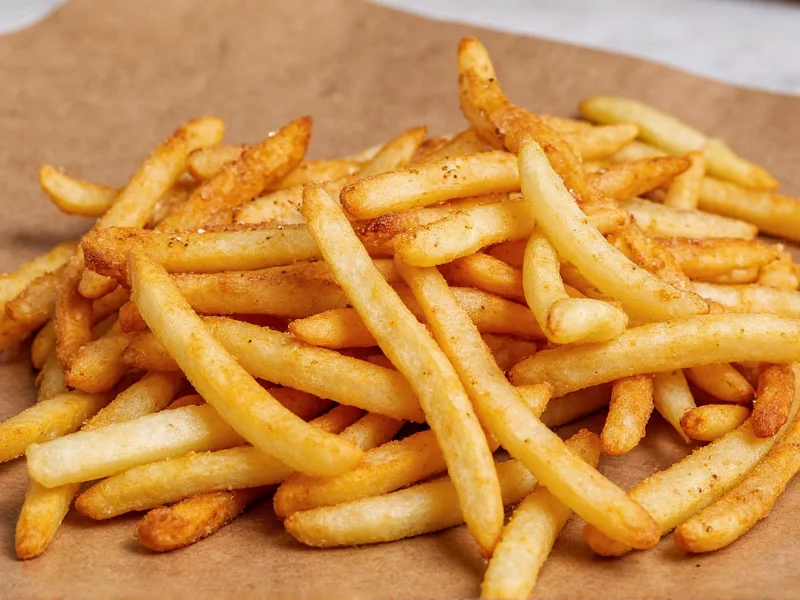Why Certain Seasonings Work Best with Fries
Fries provide a neutral canvas that pairs well with both simple and complex seasonings. The key scientific principle involves moisture adhesion: freshly fried potatoes have a slightly moist surface that helps seasonings stick. As fries cool, this moisture evaporates, making later seasoning less effective. The starch content in potatoes also creates microscopic pockets that trap seasoning particles when applied at the right temperature (approximately 160-180°F).
Classic Seasoning Combinations That Never Fail
Traditional salt remains the most popular fry seasoning for good reason—it enhances natural potato flavor without overpowering. But proper salt selection matters: fine sea salt dissolves quickly on hot fries, while flaky Maldon salt provides textural contrast. For maximum impact, combine salt with freshly cracked black pepper within 30 seconds of frying. This classic duo works because pepper's volatile compounds activate with heat, releasing aromatic oils that coat the fries.
| Seasoning Type | Best For | Application Tip |
|---|---|---|
| Sea salt + black pepper | All-purpose fries | Apply within 30 seconds of frying |
| Garlic-parmesan | Thicker steak fries | Mix with melted butter first |
| Smoked paprika blend | Skin-on rustic fries | Add cayenne for heat variation |
| Cajun seasoning | Waffle fries | Include after initial salt application |
| Cinnamon-sugar | Sweet potato fries | Apply when slightly cooled |
International Fry Seasoning Traditions
Cultures worldwide have developed distinctive fry seasoning approaches based on local ingredients. In Belgium, fries traditionally receive a double salt application—first while hot, then again after resting. Canadian poutine seasoning incorporates cheese curds and gravy rather than dry spices. Japanese curry fries use mild curry powder blended with garlic salt, while Mexican street fries feature chili-lime seasoning with fresh cilantro. These regional variations demonstrate how cultural flavor preferences shape fry seasoning techniques.
Creating Your Own Signature Seasoning Blends
Developing custom fry seasonings requires understanding flavor layering principles. Start with a 4:2:1 ratio—4 parts base (salt), 2 parts secondary flavor (garlic/onion powder), 1 part accent (herbs/spices). For a restaurant-quality truffle fry seasoning, combine:
- 3 tablespoons flaky sea salt
- 1½ tablespoons garlic powder
- ¾ tablespoon dried rosemary (finely crushed)
- ¼ teaspoon white truffle powder
Mix thoroughly and store in an airtight container. Apply 1-2 teaspoons per serving of hot fries. The rosemary's pine notes complement potato earthiness while truffle powder adds umami depth without overwhelming.
Timing and Technique Matter Most
Professional chefs emphasize that seasoning technique outweighs ingredient selection. The critical window for seasoning is 15-45 seconds post-frying when surface moisture remains but excess oil has drained. For thick-cut fries, toss gently in a metal bowl to distribute seasoning evenly. Never season cold fries—dry seasonings will simply fall off. When using wet ingredients like truffle oil or melted butter, apply first as a base layer before adding dry seasonings.
Special Considerations for Different Fry Types
Sweet potato fries require different seasoning approaches than regular potatoes due to higher sugar content. Their natural sweetness pairs well with warm spices like cinnamon, nutmeg, and allspice—but use sparingly to avoid cloying flavors. For waffle fries with increased surface area, bolder seasonings like cajun blends work best as they adhere to the ridges. Skin-on rustic fries benefit from coarse seasonings that complement their textured surface.
Avoiding Common Seasoning Mistakes
Many home cooks make these critical errors: seasoning too early (causing salt to draw out moisture), using pre-mixed blends with excessive fillers, or applying seasonings to cold fries. Another frequent mistake involves over-seasoning—start with less than you think you need, as you can always add more. For air-fried fries, which lack oil adherence, mist lightly with olive oil spray before seasoning to help spices stick.











 浙公网安备
33010002000092号
浙公网安备
33010002000092号 浙B2-20120091-4
浙B2-20120091-4